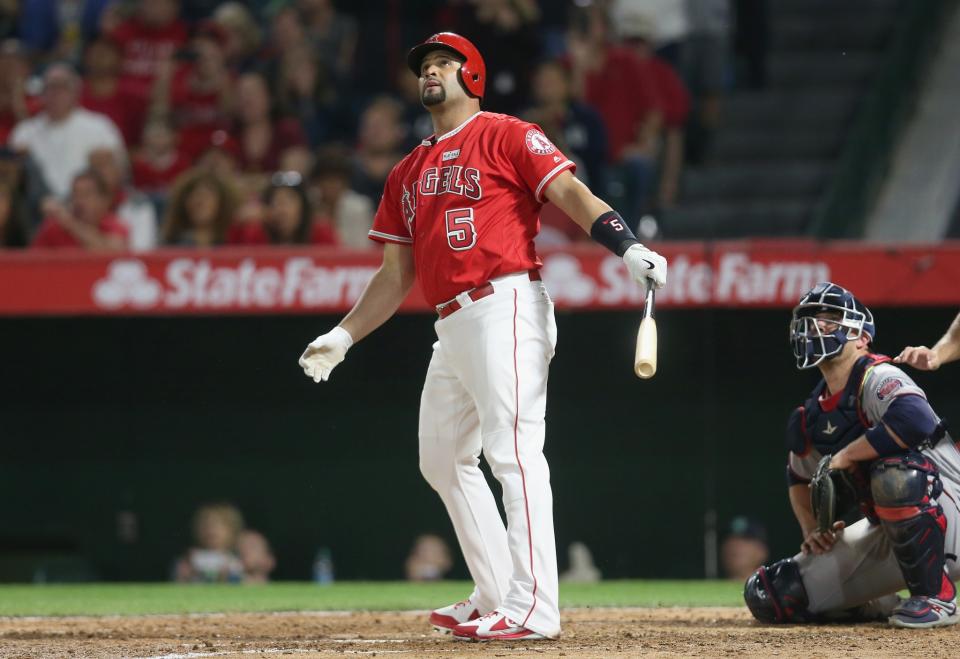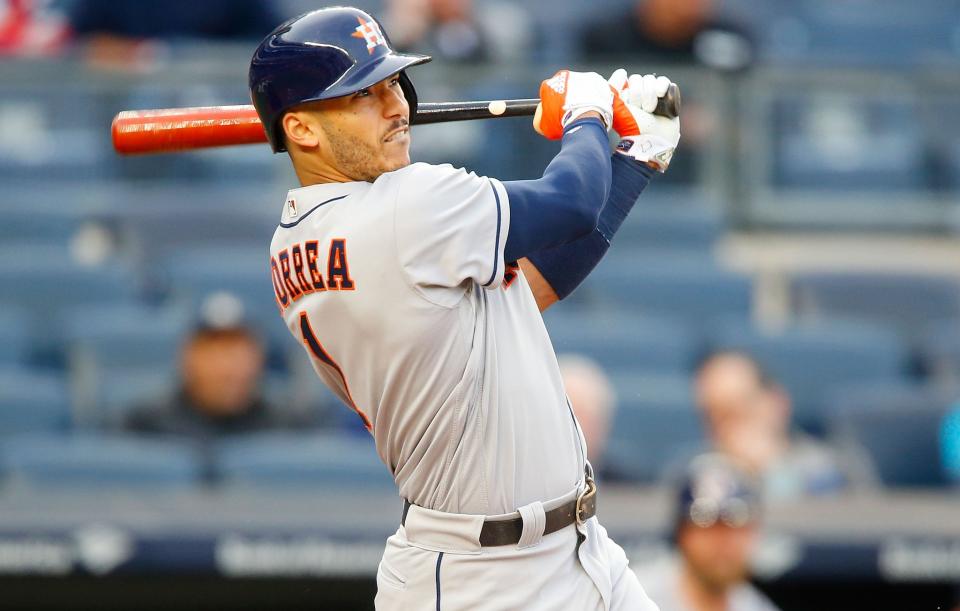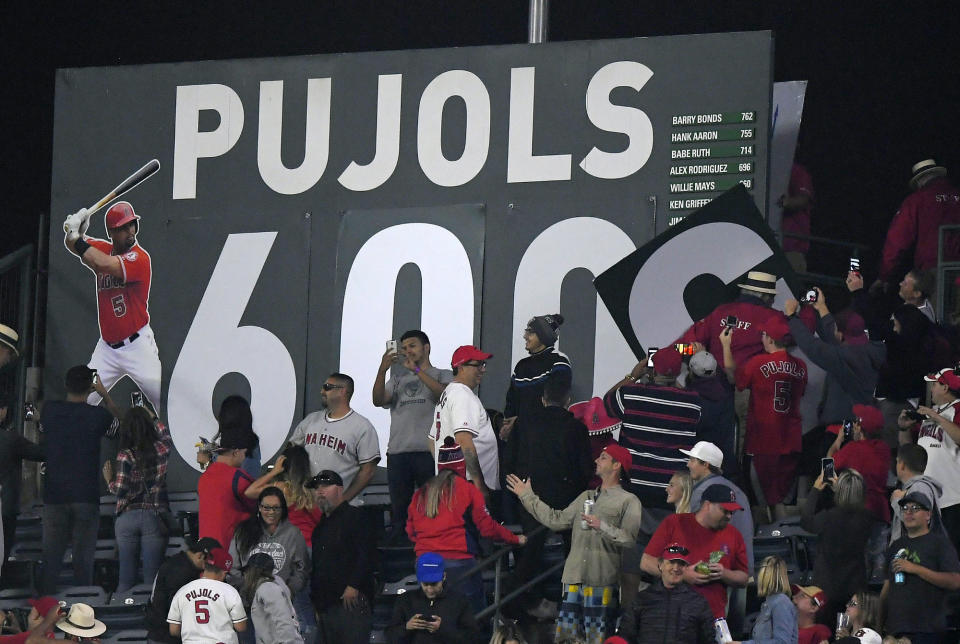As the single-year home run record stands to fall, who's next to hit 600 after Albert Pujols?
All the way back in the stone ages of 2014, the home run was dead. Strikeouts were up, walks down, offense stagnant and the one thing that could rescue it, the home run, was at a 20-year low. What happened over the next three years wasn’t simply unprecedented. It defies reason.
Major League Baseball is on pace to smash its single-season home run record in 2017 – and the weather is just beginning to warm and the balls just now starting to take off. In 2014, teams hit 0.86 home runs per game. Today, they’re averaging 1.23. That is a 43 percent increase over three years. The last jump that big over a three-year span came from 1945 to 1948, when players returned from World War II.

There is no such explanation for this jump. Unlike the 1920s, ’30s and ‘40s, when double-digit spikes and dips in home run percentage were typical, today the home run is a feature, not a bug. It isn’t just central to offense in baseball. It is offense in baseball. Players strike out more than ever. At .251, the league-wide batting average is near its low-water mark over the last half-century. Runs are scored because walks and home runs are up. Baseball has turned into a sabermetrician’s dream.
Ending the season at 1.30 home runs per game is a very real possibility – the rate tends to tick up about a tenth per game during the summer – and it would mean players hit more than 6,300 home runs, a 10.7 percent increase from the record of 5,693 set in 2000.
It’s funny, then, that in the aftermath of …
1. Albert Pujols walloping his 600th home run Saturday, one look at the home run leaderboard among active players revealed a fairly barren landscape when it comes to the next player to reach the threshold.
For all the talk that 600 lacks the cachet it once did, it is still a magnificent feat to reach, and the seeming improbability of anyone in this era post-Pujols doing so only magnifies that. The spike in home runs may change the calculus on this, but remember: Between Aug. 21, 1931, when Babe Ruth hit his 600th home run, and Aug. 8, 2002, the day before Barry Bonds launched No. 600, only three players crossed the threshold. Three, in nearly 71 years.

The decade after Bonds added five members to the club, and Pujols joined him, Ruth, Henry Aaron, Alex Rodriguez, Willie Mays, Ken Griffey Jr., Jim Thome and Sammy Sosa in it. While Pujols’ place wasn’t exactly ordained, he reached the 300-homer divide nearly a year and a half faster than his brethren, doing it seven years, three months, two days after his debut (compared to A-Rod’s eight years, eight months, 25 days).
Going from 300 to 600 was more of a struggle, though at 16 years, two months, one day of time in the big leagues, Pujols was only a month behind A-Rod for quickest to that mark, too. Those last 150 home runs, though – they’re the ones that took the longest, at more than five years. And they’re why even though …
2. Miguel Cabrera seems like a fairly decent bet to reach 600, he’s got some wood to chop, if history and his own evolution have anything to say about it.
Some details first: Cabrera, the Detroit Tigers’ star first baseman, is 34 years old and has 451 home runs. His offensive output has avoided the same cliff Pujols’ had rolled down by this point. He is under contract through 2023, giving him at least 6½ seasons to be paid to hit 149 home runs. This seems reasonable.
Now for the tough part. Only one player has hit his 600th home run past his 39th birthday: Thome. That’s not a dream killer, especially with nutrition and training what they are today. What may be is if Cabrera’s batted-ball profile doesn’t change. He is pulling the ball less than ever, just 30.5 percent of the time, and while part of the beauty of Cabrera is his opposite-field power, the older a hitter gets, the more his home runs come from the pull side. (See: Ortiz, David and, yes, Pujols, Albert.)
Close though he may be, Cabrera is no sure thing, particularly if he doesn’t evolve like Pujols did. Which, actually, would be counterproductive, seeing that age-34 Cabrera, even the version with just five home runs this year, is better than age-34 Pujols. Father Time and baseball make for a dastardly combination, and it’s why beyond Pujols and Cabrera, these 10 Degrees consist purely of players in their 20s, the youngest of whom is …
3. Carlos Correa at 22 years, 256 days. Seeing as Thursday will mark the second anniversary of his major league debut, it’s not as though we’re dealing with some neophyte here. As we saw in May, Correa’s inclusion on this list of those with potential for 600 is entirely warranted.

Quick caveat: Carlos Correa has barely half a hundred career home runs. This is some 1840s-level speculating. All the ingredients exist, though. The age. The size. The raw power. The game power. The .385/.457/.673 slash line last month as the Astros started this run that has them at 41-16, the best start for any team since 2001, and on a 117-win pace.
With his 52 homers, Correa is the leader among active 22-year-olds. Rougned Odor tops the 23-year-olds with 65, and while his power is beyond question, the prospect of him turning into a powerful and patient hitter – a practical prerequisite for all non-Sosa members of the club – isn’t great. When it comes to …
4. Bryce Harper, on the other hand, he is already there. His 15 home runs and 33 walks rank among the league leaders, and his 136 home runs are tops among all 24-year-olds and would place him near the top of the odds list for potential 600-homer members.
Still, it’s worth noting that although Harper is in his sixth season, he reached the 25-homer threshold in exactly one, his 42-homer MVP season. Otherwise, Harper has been at 22, 20, 13 and 24 last season. His line this season is almost identical to that MVP campaign, which makes Harper’s prospects for 600 far greater.
He needs more of those 40-homer years. Every member of the 600-homer club hit 40 at least six times. The only hitters with six-plus 40-homer seasons that aren’t members: Mark McGwire (583), Harmon Killebrew (573) and, naturally, the immortal Adam Dunn (462). Like Harper …
5. Mike Trout has some catching up to do in that category as well. Thumb surgery takes this season out of the running, giving Trout just one 40-homer-plus season among his six years in the big leagues.
At the same time, Trout is quite well-positioned with 184 home runs at 25 years old, and behind Cabrera, he’d likely break with the best odds to reach the mark. Age. Accomplishment. Even greater power, with a .742 slugging percentage before his injury. The best eye in the American League. A cratering strikeout rate.
This is why losing Trout for months is such a bummer for fans who appreciate greatness. His peers are Hall of Famers. That is no exaggeration, either. Trout has been their equal, and the fact he’s only 262 days older than …
6. Aaron Judge seems impossible. It’s true, though, and Judge is on this list only to serve as a proxy for every college player out there and show the difficulty in one reaching 600.
The only four-year college player to reach 600 is Bonds, and he was the oldest at his major league debut, too: 21 years, 310 days. Judge was a first-round pick out of Fresno State who made it to the big leagues during his third season, and even with his MVP-type first third of a season, he doesn’t have as many homers in the big leagues as he does years on this earth.
Let’s use another example: Kris Bryant is one of the best pure power hitters in the major leagues – and his chances of reaching 600, while not nil, are far, far less than a player who signed out of high school or as an international free agent and debuted before his 21st birthday. Bryant’s first game came at 23 years, 103 days, and while his 77 home runs are impressive, he’s more than 100 behind fellow 25-year-old Trout and won’t come anywhere close to catching the 223 home runs …
7. Giancarlo Stanton has hit thus far through his age-27 season. When Stanton arrived in the big leagues at 20 years old and hit a home run every 16.3 at-bats, he had as 600 of a look as one that age could. And when he followed with 34- and 37-homer years and took 93 home runs into his age-23 season, he was baseball’s best hope.
The game is fickle, though. Players get hurt. They falter. Stanton has done some of the former and enough of the latter to slow his pace and at least plant the seed of doubt. His 15 home runs this season, rockets and moonshots and all sorts of other NASA metaphors that make him baseball’s biggest Spaceman since Bill Lee, are a reminder of how good Stanton can be and how all it takes is a few healthy seasons for him to pile up 50 homers at a time.
With the ball flying like it is – and pitchers around baseball are convinced it’s the culprit of the home run spike more than PEDs or some proliferation of new, higher-launch swings – the prospect of Stanton even putting up a 40-homer season, something he still hasn’t done, grows by the day. When Stanton or …
8. Manny Machado put barrel to ball, the result is something beautiful and glorious and almost symphonic, from the sound of sphere hitting bat to that of the oohs and ahhs in the crowd to the consumption of what really happened afterward.
Machado’s struggles this season (.219/.296/.442) are obvious, and hitting just 33 home runs in his first three seasons negated Machado’s debut at 20 years old. His 117 home runs leave him some catching up to do with others near his age. Those long ones, though – they remind that Machado generates unique power.
Three times this season, he has launched home runs at least 465 feet. The first left Machado’s bat at 113.9 mph and landed 470 feet away, the second 113.4 mph and 466 feet and the last over the weekend against Rick Porcello 114.3 mph and 465 feet, the first ball to reach the second deck of Camden Yards in more than half a decade.
Judge hasn’t hit one that far this year. Stanton, the king of the long home run, has only two. Not even …
9. Joey Gallo, the Statcast crown prince, he of the average 108.3-mph exit velocity on his home runs, can’t match Machado foot for monster foot, at least not yet. The splendor of a Gallo plate appearance is what can be.
Nearly half the time, it ends up as a strikeout, which is not exactly an ideal outcome. Nevertheless, Gallo’s 16 home runs have him near the top of the AL leaderboard, and he is still just 23 years old. Of the game’s non-established young players, or perhaps mildly established, he may be the best hope for 600, which doesn’t say a whole lot.
The best power hitter in the minor leagues, Cody Bellinger, graduated to the Dodgers and has acquitted himself well, but putting a guy 12 homers into his career on a list of potential 600-homer guys isn’t exactly fair. The minor leagues don’t have any Gallos or Stantons or Judges at the moment. Eloy Jimenez of the Cubs put on a BP show at the Futures Game last year, a la Gallo a couple years earlier, and will hit for average in the big leagues as well. Yoan Moncada may be the best prospect in the minors due in large part to his power. It’s just not 600-homer power. Dylan Cozens with the Phillies has 80-grade raw power, the highest level possible on the scouting scale. Scouts just aren’t sure it ever will play at the major league level.
Then there are those upon whom you can dream, like Vladimir Guerrero Jr., who is 18 years old and destroying A ball. Everything is there. It was for his dad, too. And he finished with 449 home runs. That puts into perspective what …
10. Albert Pujols and the other members of the 600-homer club have done. It is a staggering achievement, and the best part is it allows us to remember when Pujols was so much more than a one-dimensional slugger.
He was nothing less than one of the most fearsome right-handed hitters the sport ever has seen. In his first decade in the major leagues, Pujols hit .331/.426/.624 with a 172 OPS+. Here’s the list of players over their first 10 years with an OPS+ that high: Ruth, Ted Williams, Lou Gehrig, Ty Cobb, Rogers Hornsby, Mike Trout, Jimmie Foxx, Mickey Mantle and Stan Musial.

Look at that list. All of the retired ones are on, what, the top-15-of-all-time list? Top 10? It’s a stunning group, and Albert Pujols was in it. We can appreciate him for the home runs, because a rundown of the rest of the leaders in the big leagues today, by age, show us how rare a player like Pujols is. Mike Moustakas has the most homers among 28-year-olds with 95. Next are Justin Upton (29, 231), Jay Bruce (30, 254), Chris Davis (31, 253), Matt Kemp (32, 250), Ryan Braun (33, 292), Cabrera, Adrian Gonzalez (35, 309), Jose Bautista (36, 318), Matt Holliday (37, 307), Adrian Beltre (38, 446), Carlos Beltran (40, 428) and, of course, Ichiro (43, 115).
The new home run era could unveil stars at a far greater rate than recent years, maybe one commensurate with the steroid era that fueled Bonds’ drive from 300 to 600 that took only five years, 11 months and 13 days. For now, baseball just gets to watch the balls fly, watch records set and watch Albert Pujols, still a slugger, set his sights on 700 and beyond.


